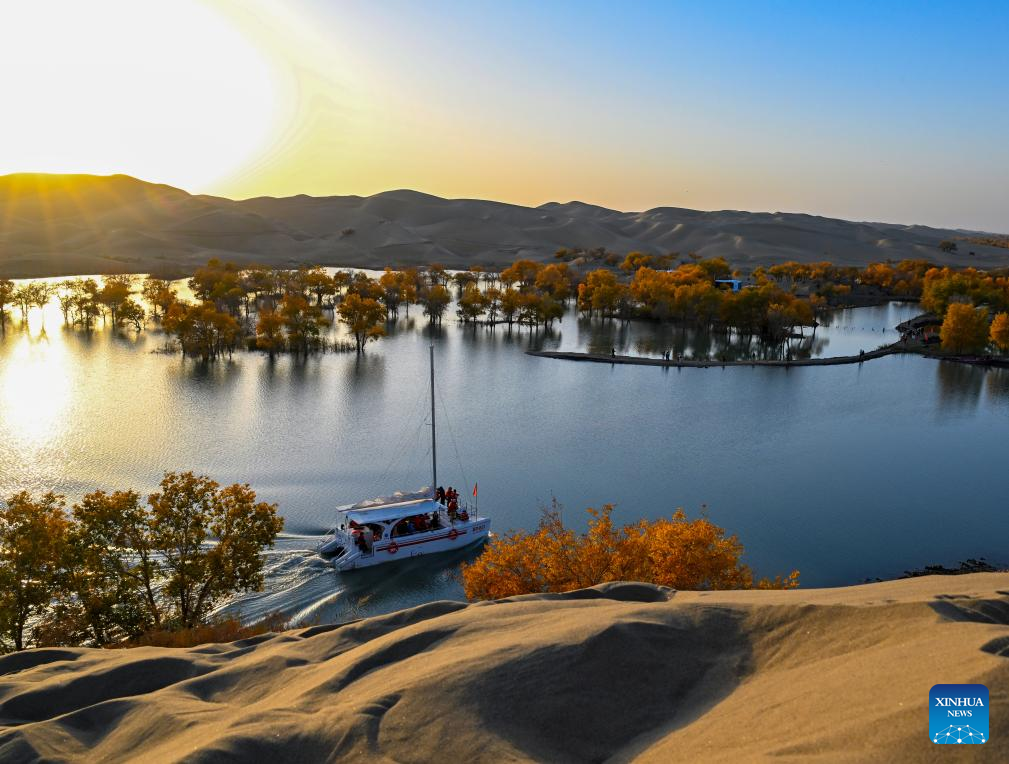


A cruise ship loaded with tourists sails on a lake in the Huludao scenic area in Bayingolin Mongolian Autonomous Prefecture, northwest China's Xinjiang Uygur Autonomous Region, Oct. 25, 2024. (Xinhua/Chen Shuo)
URUMQI, Oct. 29 (Xinhua) -- Standing atop a 100-meter dune in the Huludao scenic area, located in the Bayingolin Mongolian Autonomous Prefecture in northwest China's Xinjiang Uygur Autonomous Region, Helen Wong Lam gazes out at the golden populus euphratica forests, camera in hand.
"It's exhilarating!" exclaimed Lam, who traveled from Hong Kong to Kashgar with six friends, immersing themselves in Xinjiang's autumn charm for over half a month, all the way to this golden paradise.
"Capturing autumn's vibrant hues in Xinjiang's wilderness is a completely new experience," said the 70-year-old.
Huludao, or Calabash Island, named for its shape, sits along the eastern edge of the Taklamakan Desert, where the Tarim River winds through sands, creating a 2,000-mu (approximately 133-hectare) oasis.
Dotted with swaying golden populus euphratica forests, this once-isolated area has now emerged as a popular autumn destination, drawing visitors from near and far to admire its unique desert-meets-water splendor.
"In recent years, our company has worked closely with the local government to improve infrastructure, boost accessibility, and create new tourist amenities, all to enhance the visitor experience," said Zhang Jie, a manager at the scenic area.
Noting that October is the peak season, the manager added that campgrounds and guest rooms have been fully booked this month, with many guests even reserving as early as May.
Along the riverbanks, an array of vehicles reflected the area's popularity, with license plates from distant provinces like Yunnan, Zhejiang, and Guangdong. Some visitors strolled leisurely, while others used drones to capture vibrant moments against the golden autumn backdrop. Photographers claimed the best vantage points, and live-streamers shared the scenery with eager audiences online.
As the tourist influx rises, local authorities and the management team remain mindful of the need to balance development with nature conservation. "The unspoiled natural beauty is the most captivating aspect of this breathtaking scenery," said Zhang, adding that beyond infrastructure development, most of the investment is directed toward conservation.
Meanwhile, the growing flow of tourists has also brought job opportunities for locals like Eli Suleiman, a 44-year-old camel handler. Leading his camels, Eli Suleiman and his colleagues recreate an ancient Silk Road ambiance for visitors, introducing them to Xinjiang's rich heritage and natural beauty.
"I always thought of the desert as a barrier to the outside world, and I never imagined meeting so many people here or that I could earn a good income from the sands and trees," he said.
The spectacle of travelers journeying thousands of miles to capture Xinjiang's autumn highlights the region's booming tourism. "I hope that in the future, more visitors will come to bask in the golden autumn glow of the populus euphratica forests along the Tarim River amidst the vast desert," said Zhang. ■

Helen Wong Lam (front) and her friends from Hong Kong take photos of the populus euphratica forests atop a dune in the Huludao scenic area in Bayingolin Mongolian Autonomous Prefecture, northwest China's Xinjiang Uygur Autonomous Region, Oct. 24, 2024. (Xinhua/Chen Shuo)
点击右上角![]() 微信好友
微信好友
 朋友圈
朋友圈

请使用浏览器分享功能进行分享
